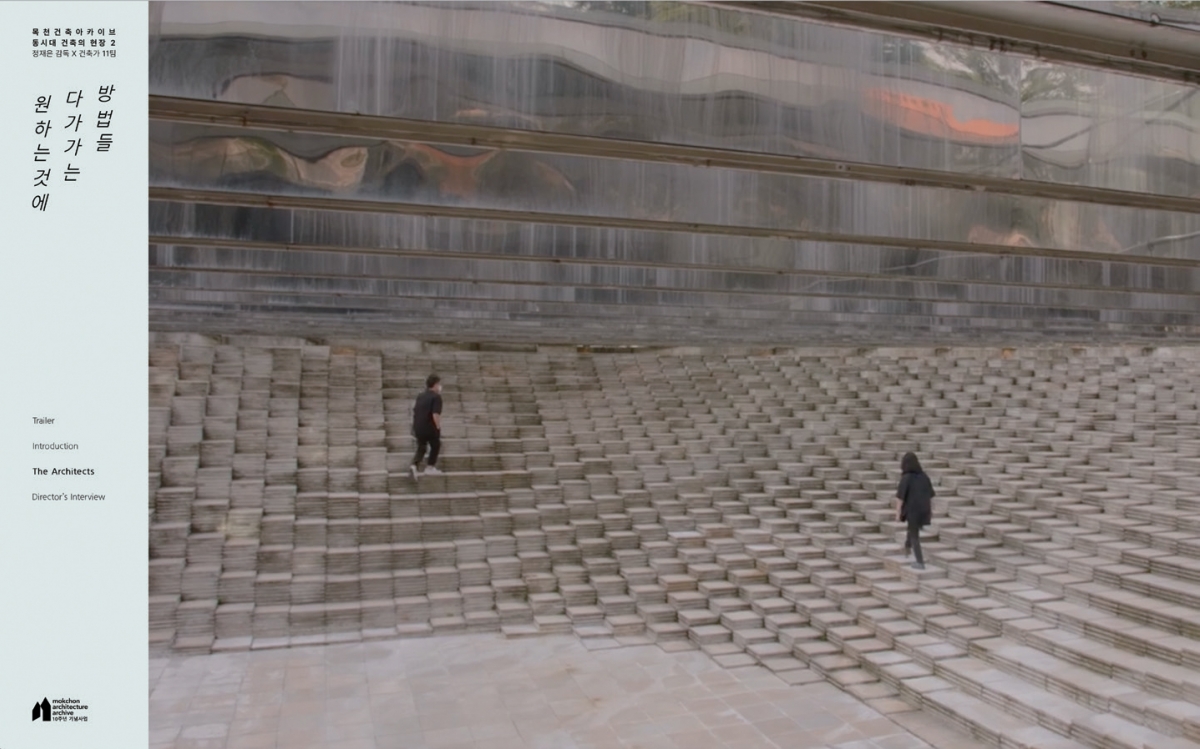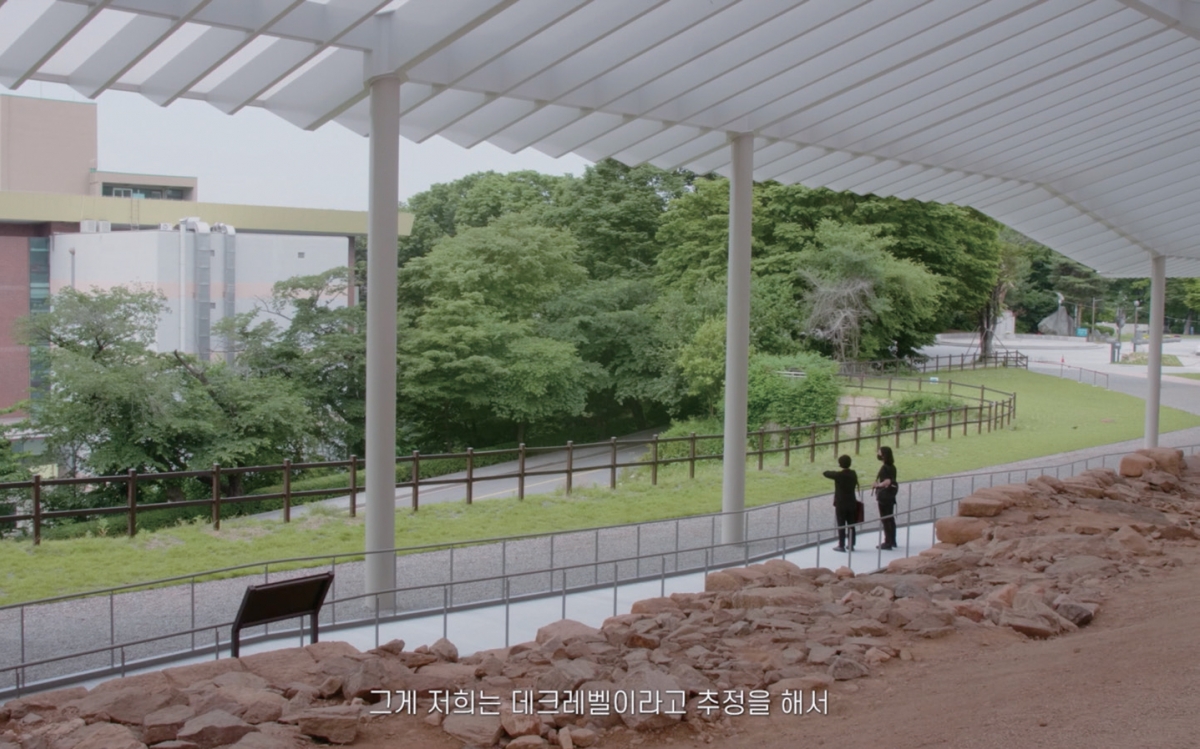
©Jeong Jae-Eun + Mokchon Foundation
SPACE May 2022 (No. 654)
The Mokchon Foundation, founded in 2010, has been working on the ‘Current Korean Modern Architecture Archive’ project for more than a decade, archiving oral histories of senior architects. In 2019, the organisation expanded the scope of its interests and published a series entitled ‘The Scene of Contemporary Architecture’ after the release of Power of Doubt. The second segment in the series was released online in March of this year. This 11-episode-film named Ways to draw what you want was produced in collaboration with the film director, Jeong Jae-Eun. The perspective of the film’s director, as well as the decision to draw extensively on archival material, is comprehensible through the on-site montage of contemporary (female) architects practicing their professions and exploring their concerns. Let’s hear from Mokchon Foundation whose activities are considered one of the most rigorous representations of the modern and contemporary history of Korean architecture and steadily making the march of progress.
interview Kim Mihyun chief director, Mokchon Foundation, Kim Taehyung researcher, Mokchon Foundation × Bang Yukyung
Bang Yukyung: Mokchon Foundation (hereinafter Mokchon) has overseen the archiving of Korean modern and contemporary architecture (architects) over the last 10 years, under the aegis of the Mokchon Architecture Archive. Please tell us how the project began and your perspective on its achievements.
Kim Mihyun: Archiving efforts were initiated a year after the inauguration of Mokchon, when we delved into the Annotations on Modern Architectural Drawings of the Japanese Colonial Period (2008 – 2014) by Jeon Bonghee (professor, Seoul National University). We made our project manifest by pursuing academic purposes and began archiving materials under the direction nominated by the operating committee. Beginning with Oral History of Architect, Kim Jungsik (2013) to the Oral History of Architect, Yoo Kerl (2020), nine books have been published. I believe the essential thrust of archiving lies in the use of the materials. If it is composed in a fair way, new topics and stories will emerge from the methodologies behind how to process and organise the raw data. In this aspect of our project, we can say what we do is an attempt to grasp architecture as a cultural product.
Bang Yukyung: ‘The Scene of Contemporary Architecture’ series attends to current architects, unlike other existing oral history’s publications. As for the first release, Choi Moongyu (professor, Yonsei University) and Pai Hyungmin (professor, University of Seoul) published a dialogue publication, Power of Doubt. What motivated you to expand your target of interest to ‘contemporary architects’?
Kim Mihyun: I believe the last generation that kept oral histories are those who were born in the 1930s to 1940s. From discussion with the operating committee, we sort of sensed that the series needed to wrap. So, we started to look for the approach to take when approaching the work of the next generations. That is how we came to think of pairing contemporary architects with a specific critique or a theorist to draw something out of the conversation that is worthy of attention, if the primary track in our work is to record and compile data through oral recordings. This is the beginning of ‘The Scene of Contemporary Architecture’ series.
Kim Taehyung: I believe our ongoing oral history project documenting the work of senior architects touches on the fundamental properties informing our archival efforts. If the original role of the archive is to collect, organise, and preserve records after the active years in he architect’s career, then ‘The Scene of Contemporary Architecture’ serves as an instrument for recording the present stories of contemporary architects.
Bang Yukyung: Ways to draw what you want is a brand new approach in that it is a video instead of book. Has there been any shift in your approach to publishing? How did you collaborate with Jeong Jae-Eun?
Kim Mihyun: People don’t read books anymore! (laugh) We chose to diversify the medium to gain more attention and engagement from the public. The year 2021 marked the 10th anniversary of the Mokchon Architecture Archive. The operating committee agreed to record working contemporary architects on-site in video format. We met with Jeong for advice in the first place, but we ended up assigning the entire project to the director, after the initial proposal of his topics of interest. Her suggestion was to follow the female architects, and we doubted this approach at first as the term ‘female’ might mislead our intentions by setting our work in the context of feminism. However, as in the previous archival efforts made by us, it is considered improper for us to intervene as it was at the researchers’ discretion to choose subjects among preferred architects. Progress advanced without any intervention.
Kim Taehyung: Jeong demonstrated his interest in the varied roles of architects. It was expected that the outcome would show which roles architects are serving in modern times, through footage covering business operations within the design studio, communication on sites, troubleshooting methodologies, and so on. It was one of our greatest achievements to create the chance to watch how present day architects work in close collaboration and find a common ground.
Bang Yukyung: The list of participating architects is colourful in terms of the scope of work, design methods, business operations, and so on. How did you select them?
Kim Taehyung: When listing the participating architects, we tried to avoid overlapping characters, and so in privileging the distinct identity of each architect this has been made evident. At the beginning of the planning phase, the Mokchon and Jeong browsed the works, media exposures, lectures, bibliographies of ten architectural studios, exploring keywords such as public architecture, dwellings, office, exhibition, local architecture, archive, and urban research. We built up a storyboard covering which subject would be addressed at each point of the shoot. Kim Mihyun: As mentioned in the ‘Director’s Interview’, the Mokchon and Jeong completed the list and shared it with the operating committee to heed their idea. The one participant who stands out on the list is senior Chi Soon. She wasn’t on the list of interviewees, but the dedication was made as she passed away last September and Jeong happened to be the last person who interviewed her.

©Jeong Jae-Eun + Mokchon Foundation
Bang Yukyung: The videos feature various fields covered in the profession, how they control the construction sites, how they talk with their associates, and even a conflict scene between designers. Which process was taken to achieve a lively take in the film?
Kim Taehyung: Before the crank-in, we had individual meetings with the architects. We requested that it be filmed in the formats of Documentary 3-days, but the ongoing projects were to be introduced as they stand. We installed cameras in and around the office, and Jeong and I hid behind spaces and shot the video. It typically takes two and a half days to shoot the office and the site scenes, and so the rest was given over to taping interviews based on the dialogue and footage captured in the studio.
Bang Yukyung: What are the characteristics behind the works of contemporary architects from the archival point of view?
Kim Taehyung: In the past, architects tended to focus on architecture itself, reading and expressing it and it alone. It was interesting to chart the extended scope of interests, perspectives, and expressive forms to be found in modern-day architects who are thriving in our evolving society and diversified perception. The unique character of each architect seems to greatly impact the role of the architects and the design process. The flow in gleaning new ideas through exhibitions and research to applying them to the projects (Kang Yerin, Lee Chihoon), a method of producing a variety of materials through collaboration with her father with the help of home-made digital fabrication (Lee Taekyoung), and a working style of assigning a single project to each designer and advance the project through 1-on-1 consultation (Chung Hyuna) gave me a huge amount of inspiration. One day, Lee Minah told me that it is her pleasure to research sources for the projects, and this habit distracted her greatly when she assumed Gongpeyong Historic Site Museum, Hanyangdoseong On-site Museum project. (laugh) It was impressive to me personally that Kim Jeongim is able to memorise quotes from books she read and uses them as evidence for judgments for work and everyday life.
Kim Mihyun: There are many sources of inspiration behind the architect’s imaginative endeavours, including books, movies, and exhibitions. Archiving after attaining a more thorough appreciation of the references will shed a light on concurrent scenes and architectural works. If possible, instead of arranging the records of a building as colourless materials, I want to produce them in the form of archive sketches created by an architect and an archivist.
Bang Yukyung: From the film, I sensed that architects nowadays feel obliged to answer big questions such as ‘what roles am I serving in this society?’
Kim Taehyung: I think the examples by Chung Hyuna reveal this trend very clearly. Her works are carried out mainly in Gangnam blocks, in Seoul, and she said she wants to see how the buildings will be used after her retirement. To her, the extent to which the building stands out isn’t her primary concern, but it is ‘how it transforms and survives’ that matters. Given the tenets of the Pritzker Prize these days, it is necessary to think more deeply about the role of architects and architecture.
Bang Yukyung: Considering the transitional nature of our era, the experiment by Mokchon to explore new directions in the archive is still ongoing. What is the direction of Mokchon to keep moving forward?
Kim Mihyun: It will be valuable to understand how the participating architects have changed over 10 years. I wonder if they will remain as they are now, and how they conceive of the social and public aspects of architecture. (laugh) Mokchon lingered in the archives for more than a decade, and this led us to discover which area from the 1950s to the 2000s isn’t fairly represented. If modern and contemporary architectural records aren’t sorted properly now, many raw data will be missing in the long run. It is our duty to collect and preserve data from before the 2000s. We are concerned with locating data with sources and addresses that can be intertwined vertically and horizontally. The purpose of ‘The Scene of Contemporary Architecture’, of course, is to promote our own practice, but we also want to spread awareness that the works and the activities of architects belong to us. We will pursue our business in dual tracks as much as we can. We hope that the next generation can exploit the data on the basis of our archives.
Kim Taehyung: Since the establishment of the Korea Institute of Registered Architects in 1965, Korea was equipped with an apparatus to foster skilled workers in the field of architecture. The role of the Korean architects during Korean liberation, the post- war era, and the period of national economic development was influenced by national policy. It is our greatest interest to address how we record the role of the architecture and architects in these particular periods. One good example is architecture resulting from the industrialisation or the social needs in the 1960s and 1970s, and how the part that is related to urban planning, the emergence of satellite cities and the restructuring of government organisations, and subsequent redevelopment and new town planning can be categorised in such a context.
part of the Mokchon Architecture Archive since 2011.




